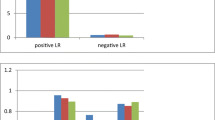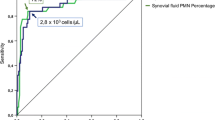Abstract
Background
Isolation of bacteria from synovial fluid (SF) is the gold standard for diagnosis of septic arthritis (SA). Contamination results in misdiagnosis and mismanagement. This study identifies clinical characteristics, microbiology, and outcomes of patients with contaminated SF and compares them with patients with true SA.
Methods
We conducted a retrospective study including all patients aged 18 and older admitted to a single, tertiary-care hospital between 1998 and 2015 with suspected SA and positive SF cultures. Contamination cases were determined by infectious disease specialists involved in the patients’ care and a clinical course inconsistent with SA.
Results
398 patients with true SA and 22 with contaminated SF were identified. The SA group was younger (60.9 vs. 75.6 years; p < 0.01), had higher peripheral polymorphonuclear lymphocytes (78.0 vs. 69.4%; p < 0.01) and SF white blood cell count (91.7 vs. 25.6K/mL; p = 0.02), and longer mean length of stay (10.9 vs. 6.7 days; p = 0.02). The average time to positive culture was longer in the contaminated group (3.62 vs. 1.4 days; p < 0.01). The SA group was less likely to receive a new rheumatologic diagnosis within 1 year (3.0 vs. 36.4%; p < 0.01).
Conclusion
This is the first study of its kind looking at clinical features and outcomes of patients with contaminated SF. These patients present with less severe disease, have better outcomes, and receive new rheumatologic diagnoses in more than a third of cases within 1 year. We recommend a conservative approach for patients with suspected contaminated SF, mild symptoms, and no bacterial growth within the first 48 h.


Similar content being viewed by others
References
Souvenir D, Andersion DE Jr, Palpant S, et al. Blood cultures positive for coagulase-negative staphylococci: antisepsis, pseudobacteremia, and therapy of patients. J Clin Microbiol. 1998;36:1923–6.
Bates DW, Goldman L, Lee TH. Contaminant blood cultures and resource utilization. JAMA. 1991;265:365–9.
Bates DW, Cook EF, Goldman L, Lee TH. A prospectively validated model for predicting bacteremia in hospitalized patients. Ann Intern Med. 1990;113:495–500.
Weinstein MP, Towns ML, Quartey SM, et al. The clinical significance of positive blood cultures in the 1990s: a prospective comprehensive evaluation of the microbiology, epidemiology, and outcome of bacteremia and fungemia in adults. Clin Infect Dis. 1997;24:584–602.
Richter SS, Beekmann SE, Croco JL, et al. Minimizing the workup of blood culture contaminants: implementation and evaluation of a laboratory-based algorithm. J Clin Microbiol. 2002;40:2437–44.
Pfaller MA, Herwaldt LA. Laboratory, clinical, and epidemiological aspects of coagulase-negative staphylococci. Clin Microbiol Rev. 1988;1:281–99.
Tashiro M, Izumikawa K, Ashizawa N, Narukawa M, Yamamoto Y. Clinical significance of methicillin-resistant coagulase-negative staphylococci obtained from sterile specimens. Diagn Microbiol Infect Dis. 2015;81:71–5.
Weinstein MP. Current blood culture methods and systems: clinical concepts, technology, and interpretation of results. Clin Infect Dis. 1996;23:40–6.
Strand CL, Wajsbort RR, Sturmann K. Effect of iodophor vs iodine tincture skin preparation on blood culture contamination rate. JAMA. 1993;269:1004–6.
Weinstein MP, Mirrett S, Wilson ML, Reimer LG, Reller LB. Controlled evaluation of 5 versus 10 milliliters of blood cultured in aerobic BacT/Alert blood culture bottles. J Clin Microbiol. 1994;32:2103–6.
Seybold U, Reichardt C, Halvosa JS, Blumberg HM. Clonal diversity in episodes with multiple coagulase-negative Staphylococcus bloodstream isolates suggesting frequent contamination. Infection. 2009;37:256–60.
Mirrett S, Weinstein MP, Reimer LG, Wilson ML, Reller LB. Relevance of the number of positive bottles in determining clinical significance of coagulase-negative staphylococci in blood cultures. J Clin Microbiol. 2001;29:3279–81.
Cross MC, Kransdorf MJ, Chivers FS, et al. Utility of percutaneous joint aspiration and synovial biopsy in identifying culture-positive infected hip arthroplasty. Skelet Radiol. 2014;43:165–8.
Fink B, Gebhard A, Fuerst M, Berger I, Schäfer P. High diagnostic value of synovial biopsy in periprosthetic joint infection of the hip. Clin Orthop Relat Res. 2013;471:956–64.
Author information
Authors and Affiliations
Corresponding author
Ethics declarations
Funding
No funding sources were provided for the work done in this manuscript.
Conflict of interest
On behalf of all authors, the corresponding author states that there is no conflict of interest.
Ethics approval
All human and animal studies have been approved by the appropriate ethics committee and have, therefore, been performed in accordance with the ethical standards laid down in the 1964 Declaration of Helsinki and its later amendments.
Rights and permissions
About this article
Cite this article
Fowler, M.L., Zhu, C., Byrne, K. et al. Pathogen or contaminant? Distinguishing true infection from synovial fluid culture contamination in patients with suspected septic arthritis. Infection 45, 825–830 (2017). https://doi.org/10.1007/s15010-017-1051-y
Received:
Accepted:
Published:
Issue Date:
DOI: https://doi.org/10.1007/s15010-017-1051-y




